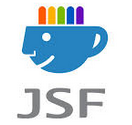JBoss RichFaces 3.3JBoss RichFaces is a rich component library for JavaServer Faces and an AJAX framework that allows easy integration of Ajax capabilities into complex business applications. Do you wish to eliminate the time involved in writing JavaScript code and managing JavaScript-compatibility between browsers to build an Ajax web application quickly? also read: Introduction to JSF JSF Interview Questions …
Richfaces
Use rich:datascroller for rich:dataTable pagination
rich:datascroller and rich:dataTable rich:dataTable tag is the RichFaces version for datatable component which has few extra features on look and feel.One of the difficulty JSF developers is creating good pagination for the data dsiplayed using rich:datatable. To resole this problem, RichFaces tags library provides rich:datascroller component which can display the automatic paginations based on data …
How to set selected tab in rich:tabPanel tag?
Topic : Java Server Faces (JSF), RichFaces, Ajax4Jsf Environment : J2EE 5.0, MyFaces 1.1.5, RichFaces 3.1.0 rich:tabPanel also read: Introduction to JSF JSF Interview Questions Request Processing Lifecycle phases in JSF This example illustrates how to set the selected tab in rich:tabPanel. This tag is used for creating the multiple tabs with in same page …
Introduction to Ajax4Jsf
Java Server Faces provided a Component Based Architecture for building User Interface Components for the Web Application. Ajax aims in providing Faster Response to the Client Applications by reloading only the needed Data. Wouldn’t be nice to take the advantages of both Jsf and Ajax for developing Robust Web Applications. Ajax4Jsf provides solution for this. …

